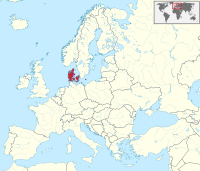Welcome to the Denmark Portal! | ||||

|

|

| |
Denmark is the smallest and southernmost of the Nordic countries. Unified in the 10th century, it is also the oldest. Located north of its only land neighbour, Germany, south-west of Sweden, and south of Norway, it is located in northern Europe. From a cultural point of view, Denmark belongs to the family of Scandinavian countries although it is not located on the Scandinavian Peninsula. The national capital is Copenhagen.
Denmark borders both the Baltic and the North Sea. The country consists of a large peninsula, Jutland, which borders Schleswig-Holstein; many islands, most notably Zealand, Funen, Vendsyssel-Thy, Lolland, and Bornholm; and hundreds of minor islands often referred to as the Danish Archipelago. Denmark has historically controlled the approach to the Baltic Sea, and those waters are also known as the Danish straits.
Denmark has been a constitutional monarchy since 1849 and is a parliamentary democracy. It became a member of the European Economic Community (now the European Union) in 1973. The Kingdom of Denmark also encompasses two off-shore territories, Greenland and the Faroe Islands, both of which enjoy wide-ranging home rule. The Danish monarchy is the oldest existing monarchy in Europe, and the national flag is the oldest state flag in continuous use.
Selected biography

Tycho Brahe, born Tyge Ottesen Brahe (December 14, 1546 – October 24, 1601), was a Danish nobleman astronomer as well as an astrologer and alchemist. He was granted an estate on the island of Hven and the funding to build the Uraniborg, an early research institute, where he built large astronomical instruments and took many careful measurements. As an astronomer, Tycho worked to combine what he saw as the geometrical benefits of the Copernican system with the philosophical benefits of the Ptolemaic system into his own model of the universe, the Tychonic system. From 1600 until his death in 1601, he was assisted by Johannes Kepler, who would later use Tycho's astronomical information to develop his own theories of astronomy.
He is credited with the most accurate astronomical observations of his time, and the data was used by his assistant Kepler to derive the laws of planetary motion. No one before Tycho had attempted to make so many redundant observations, and the mathematical tools to take advantage of them had not yet been developed. He did what others before him were unable or unwilling to do — to catalogue the planets and stars with enough accuracy so as to determine whether the Ptolemaic or Copernican system was more valid in describing the heavens.
Recently selected: Ludvig Holberg - Karen Blixen - Bertel Thorvaldsen
Selected picture
Selected article
Antoine de la Calmette was a Hugenot whose family had been forced to leave France for Holland. His father was a diplomat who after terms in Switzerland and Portugal, finally arrived in Denmark where, in 1776, the family was naturalised and recognised as Danish nobility.
In January 1777, he married Catharina Elisabeth Iselin, the daughter of the Swiss baron Reinhard Iselin who had also emigrated to Denmark. In 1783, Antoine was appointed prefect of Møn. The same year, he bought six hectares of land on the eastern coast of the island in the parish of Magleby.
He and his wife, who travelled widely, had become interested in Jean-Jacques Rousseau's philosophy of naturalism in the Age of Enlightenment. As a result, Antoine designed the park in the Romantic spirit of the time as a loving gift for his wife. It was intended as a retreat where the family could spend a few days or weeks at a time, often with invited guests, away from the hardships of their working lives at Marienborg on the other side of the island.
Selected place
Owing to its natural harbour and its strategic position in the Baltic Sea, Rønne has an interesting history coming under German and Swedish influence during its development as a herring fishing port. Today, with its quaint cobbled streets, half-timbered houses and interesting museums, it attracts visitors mainly from Denmark, Germany, Sweden and Poland.
Categories
Denmark topics
Things you can do
- Expand stubs:
Geography stubs · People stubs · Denmark stubs in general
Help us extend these stubs and make them real articles!
- Categorize:
Help us categorize Denmark-related articles
- WikiProjects:
Have a look at WikiProject Denmark, WikiProject Faroe Islands, WikiProject Greenland and WikiProject Norse history and culture
- Noticeboard:
Have a look at the Danish Wikipedians' notice board
- Geotag:
Find coordinates for these locations and tag them: articles missing geocoordinate data
Related portals
Northern Europe
Other countries
Associated WikiMedia
The following Wikimedia Foundation sister projects provide more on this subject:
-
Commons
Free media repository -
Wikibooks
Free textbooks and manuals -
Wikidata
Free knowledge base -
Wikinews
Free-content news -
Wikiquote
Collection of quotations -
Wikisource
Free-content library -
Wikispecies
Directory of species -
Wikiversity
Free learning tools -
Wikivoyage
Free travel guide -
Wiktionary
Dictionary and thesaurus













